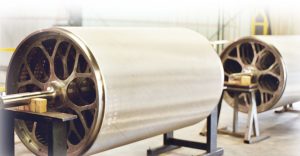Basically, a plant is compressed to release fibres. By mixing it with water, a mushy suspension occurs called pulp. The pulp is then spread over wire mesh so that the fibres knit and bond together; remove the water, and what you’re left with is paper.
Whether you’re making paper by hand or machine, there are essentially two stages to the process: creating pulp and drying it.
From pulp to finished roll, the paper passes through eight stages:
- Headbox: This where the pulp starts its journey.
- Wire mesh: Most of the water from the pulp is removed and the paper starts to form.
- Suction boxes: Water drips through the mesh and more is removed by suction boxes.
- Dandy roll: This large roller puts a watermark or texture on the paper.
- Felt belt: The paper runs over a rotating felt belt that removes further moisture.
- Dryer: The paper moves over more felt rollers and heated dryers.
- Calendars: These rollers smooth the paper so it’s completely uniform in thickness.
- Paper roll: The end-product is complete.
